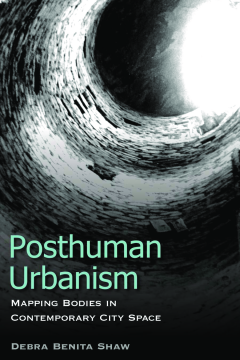
Additional Information
Book Details
Abstract
The World Health Organisation estimates that, by 2030, six out of every ten people in the world will live in a city. But what does it mean to inhabit the city in the twenty-first century?
Posthuman Urbanism evaluates the relevance and usefulness of posthuman theory to understanding the urban subject and its conditions of possibility. It argues that contemporary science and technology is radically changing the way that we understand our bodies and that understanding ourselves as 'posthuman' offers new insights into urban inequalities.
By analysing the relationship between the biological sciences and cities from the nineteenth-century onward as it is expressed in architecture, popular culture and case studies of contemporary insurgent practices, a case is made for posthuman urbanism as a significant concept for changing the meaning of urban space. It answers the question of how we can change ourselves to change the way we live with others, both human and non-human, in a rapidly urbanising world.
Debra Benita Shaw is a Reader in Cultural Theory at the University of East London. She is the author of Women Science & Fiction (2000), Technoculture: The Key Concepts (2008) and co-editor (with Maggie Humm) of Radical Space: Exploring Politics and Practice (2016).
As the world becomes predominantly urban, and as humans become increasingly entangled with other creatures and technologies, we need to combine current urban sensibilities with a feel for the posthuman condition. Combing cutting edge theories with grounded observations, Debra Benita Shaw shows us the neoliberal constitution as well as the promises of our monstrous urban lives, pointing us towards a reconstituted urban politics and praxis.
Stephen Hinchliffe, Professor in Human Geography at the University of Exeter
If cartography creates representations of space that map bodies into power, this vivid, original and utterly compelling book hacks mapping to evoke alternative ontologies of existence within hyper-surveilled prosumer cities crisscrossed by endless commuter corridors and shopping junk. Posthuman Urbanism is in fact a treasure map, one that engages acting rather than seeing. Explore the many complex and inspiring paths that it contains to find invaluable treasures: stories, imaginings and concepts hidden in dark spaces that evade normalising twenty-four-hour high security control; ways of doing and being that queer urban planning and its belief that it can fix all social problems; ways of becoming and escaping that draw energies from unexpected animal, human, technoscientific, material mixtures. By analysing how humanism and urbanism reinforce each other only to assert control over our movements in city space, this provocative and bracing read invites us to embrace posturban city spaces and, indeed, to make them. Beneath the paving stones, the posthuman urban commons.
Dimitris Papadopoulos, Reader in Sociology and Organisation at the University of Leicester and author of Experimental Politics. Technoscience, Alterontologies and More Than Social Movements (Duke University Press)
Posthuman Urbanism will be useful to students and scholars concerned with how city spaces and architecture include and exclude certain subjects through designing operations like separation, classification and disciplinary control. It is relevant to those occupied with the intersections of cultural geography and ideology, providing excellent insight into how humanism and urban space interact to stabilise the idea of the human as well as how posthumanism can disrupt the symbiotic relationship between urban space and dominant ideologies.
Table of Contents
| Section Title | Page | Action | Price |
|---|---|---|---|
| Posthuman Urbanism | Cover | ||
| Contents | v | ||
| List of figures | vii | ||
| Preface | ix | ||
| Part I: Political Anatomies of Bodies and Cities | 1 | ||
| Introduction | 3 | ||
| 1 Darwin’s Monsters | 51 | ||
| 2 Metropolitan Others | 73 | ||
| 3 Science and the Architectural Imaginary | 93 | ||
| 4 Posthuman Urbanism | 121 | ||
| Part II: Monsters in the Metropolis | 137 | ||
| 5 Scavengers and Parasites | 139 | ||
| 6 Pirates and Vagabonds | 153 | ||
| 7 Posturban Psychogeographies | 167 | ||
| Conclusion: Towards a Posthuman Cartography of Urban Space | 181 | ||
| Notes | 187 | ||
| Bibliography | 191 | ||
| Index | 207 | ||
| About the Author | 221 |
